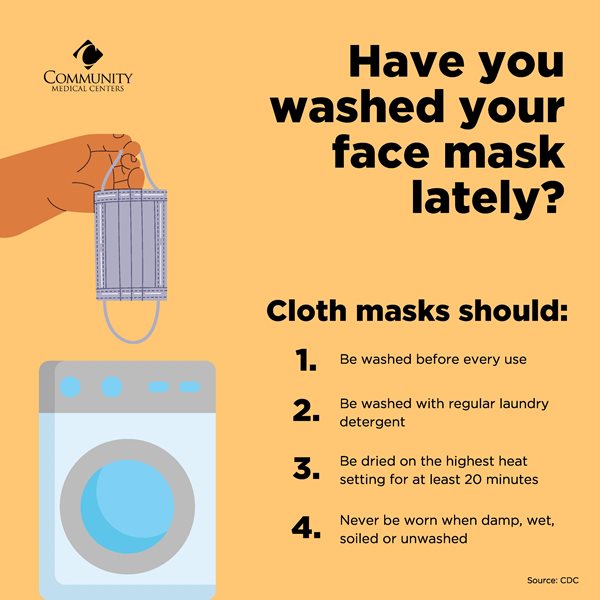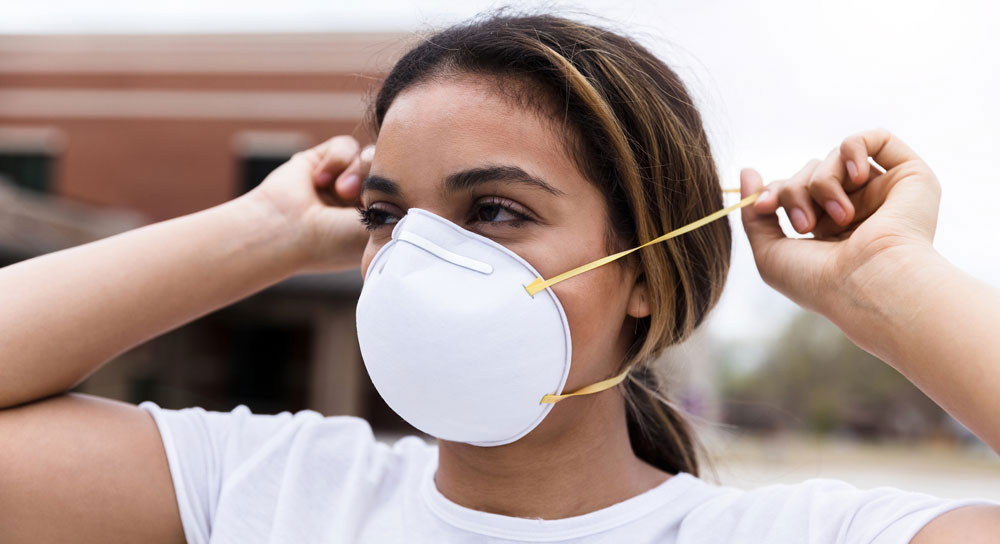However, it’s not enough to just wrap something around your face, practice social distancing, and call it good. For your own protection, it’s important to know the most effective types of masks, how to clean them, and how to wear them properly.
Face masks help limit the spread of germs. As a person talks, coughs, or sneezes tiny droplets are released into the air. Wearing a mask limits the amount of germ and virus-containing particles that can reach other people.
This also means the outside – and inside – of your mask is probably not very clean. How many people do you see every day just grabbing their mask nonchalantly to either put it on or take it off?
To prevent germs from spreading to your hands, follow these safe and simple tips provided by the CDC (Centers for Disease Control and Prevention) for putting on or removing a face mask.
#1 - Choosing your face mask
Which types of face masks are the most effective? With all of these different mask options available, it’s also essential to learn which masks are most effective, so you can make the best decision for you and your family.
Here’s a ranked list of face masks from most to least effective:
N95 respirators
N95 respirators create a tight seal around the nose and mouth. When properly fitted to the wearer and worn correctly, they can block at least 95% of small airborne particles. One reason N95 masks are so effective is because they’re made out of many layers of fine polypropylene (a form of flexible plastic) fibers.
The World Health Organization says, these fibers use the power of static electricity to trap incoming and outgoing particles and droplets. Since N95 respirators are one of the more effective types of masks, health officials ask that the public save those for healthcare workers who may need them most.
Cloth masks
A team from Florida Atlantic University’s College of Engineering and Computer Science tested a single-layer “bandana-style covering and a homemade two-layered cotton mask. What they found was that droplets traveled only 2.5 inches after coughing through a double-layered cotton mask.
The spread of COVID-19 can be reduced greatly when cloth face masks are used along with other preventive measures, like social distancing, frequent hand washing, and disinfecting commonly touched surfaces.
Bandanas
Out of all of the popular face mask options — bandanas — have proved to be the least effective, according to a study published on June 30th, 2020, in the journal Physics of Fluids. The study found that even though bandanas have a high thread count, droplets were recorded to have traveled 3-feet 7-inches after coughing into a bandana.
Surgical masks
Surgical masks are loose fitting, disposable masks intended to be worn by healthcare workers. They're primarily designed to protect other people from the mask wearer, but they also help protect the wearer from large particle droplets in the air. Although most surgical masks are made of paper, some are made of a thin plastic fabric that looks and feels like flexible paper, says Lisa Brosseau, a research consultant with the University of Minnesota's Center for Infectious Disease Research and Policy.
Research has found that surgical masks can block the vast majority of respiratory droplets emitted by an infected person. But how well a surgical mask protects you, the wearer, from smaller particles can vary widely.
#2 – Caring for and wearing your face mask
Steps for wearing a face mask:
-
Clean your hands with soap and water or hand sanitizer for at least 20 seconds before touching your mask.
-
Determine which side of the mask is the top. If you have a mask with a stiff bendable edge, that’s the top and is meant to mold to the shape of your nose.
-
Handle the mask by the ear loops/ties/bands. Place these around your ears and proceed to adjust the mask so it sits flat on the sides of your face while covering your nose and mouth. Be sure to secure the mask under your chin.
-
Make sure you can breathe normally through the mask.
Steps for removing a face mask:
-
Clean your hands with soap and water or hand sanitizer for at least 20 seconds before touching your mask. Avoid touching the front of the mask since this part of the mask is likely contaminated. Only touch the ear loops/ties/band.
-
Untie the strings that are behind your head or stretch the ear loops.
-
Fold the outside corners of the mask together using the strings or ear loops. Do not touch the outside of the mask.
-
Place disposable masks in the trash. Reusable cloth masks should be placed in the washing machine.
-
Be careful not to touch your eyes, nose, or mouth when removing, and wash hands immediately after taking the mask off.
#3 - Cleaning your face mask
The CDC recommends that cloth face coverings should be washed and dried on high heat after each use. It’s important to properly remove facemasks and always wash your hands after handling them.
Washing a face mask can be done either by hand or machine. If you choose to machine wash your cloth facemask, you can include it with your regular laundry and just use your normal detergent with the warmest appropriate water temperature for the cloth material.
If you choose to hand wash your facemask, you’ll need to prepare a bleach solution by mixing 5 tablespoons (1/3 cup) of household bleach per gallon of room temperature water. Make sure that the bleach is intended for disinfection. Some bleach products, such as those designed for safe use on colored clothing, may not be suitable for disinfection. Ensure the bleach product is not past its expiration date. Never mix bleach with ammonia or any other cleanser.
Soak your facemask for 5 minutes in the bleach solution, then rinse thoroughly with cold or room temperature water. To dry your mask, you can either put in the dryer at its highest setting until the mask is completely dry, or lay it out flat in direct sun to dry naturally.

What the Three C’s teach is that just because a face mask has higher thread count, does not automatically mean it's more effective. That’s why it’s always recommended to practice social distancing by remaining 6 feet apart when out in public and remember to wash your hands frequently.
If you have more questions about coronavirus and facemasks, visit the CDC’s COVID-19 website to stay up-to-date with the latest information.






